Agronomy Update
Jul 07, 2025
Late-Pass Corn Herbicides: What to Know Before Corn Is Too Tall
With the 4th of July in the rearview mirror, we’re officially entering the late stages of corn herbicide applications. This growing season has been unusually cool, and in many fields, corn is just now reaching the knee-high stage. But while the crop may be taking its time, weeds sure aren’t. Don’t let your guard down, there’s still work to do before full canopy.
A Look Back: Did You Hit the Early Marks?
By now, we hope your early-season program included:- A solid burndown after planting, ideally timed before corn emergence or as it was just spiking through.
- Then, as the weeds greened up:
Make sure to include Class Act (water conditioner + NIS) in the tank to get the most out of the glyphosate.
The 12-Inch Rule: Now What?
Most atrazine labels cut you off at 12" tall corn, and if you missed that window for your in crop application and your corn is past that, it’s time to pivot. Below are three options, which provide varying levels of control across a range of corn growth stagesGroup 27 Herbicides (Without Atrazine):
Group 27 herbicides can typically be applied up to V9 or 30–36” corn, depending on the specific label. Keep expectations realistic, without atrazine, these become more of a "rescue" treatment. They’ll do fine on small weeds, but don’t expect magic on big ones.
Dicamba-Based Products (Safened):
While un-safened dicamba like Sterling Blue is now off the table, DiFlexx and Status remain viable:
- DiFlexx: Up to V7 or 24” corn
- Status: Up to V10 or 36” corn
Better Yet: Stack a Safened Dicamba with a Group 27
While this combo doesn’t offer the powerful synergy of atrazine + Group 27, it does layer multiple modes of action, which improves overall control and helps manage resistance.
With all these mixes, glyphosate plus Class Act should be included in the tank.
Final Thought: Don’t Let Weeds Get the Jump
Corn is highly sensitive to early weed pressure and letting weeds grow past 3–4” before treatment is asking for trouble. The best rescue treat- ment? Not needing one. Be proactive, scout regularly, and treat early. Keep weed pressure low, and your corn will reward you.
Kyle Okke, CCA
Agile Agronomy LLC & Agronomists Happy Hour Podcast
Head Scab Risk Update
Updated scab risk maps for non-irrigated wheat and durum are provided below. According to the National model, there is currently low to moderate risk in our region for very susceptible varieties of wheat (durum and some varieties of HRSW). The NDSU model is predicting low risk across much of the state.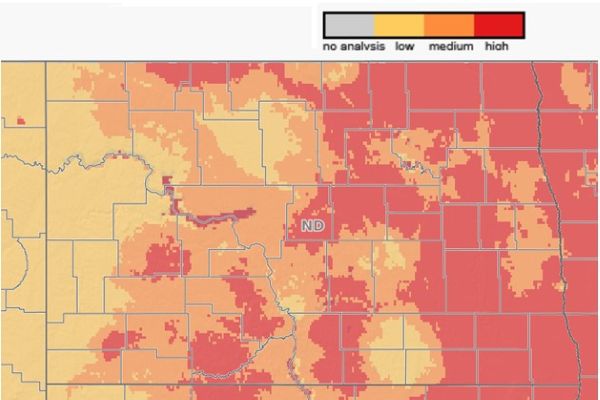

The maps above are for crops which are in the early flowering stage right now. Much of the wheat planted in April is beyond the time point where a fungicide application for head scab would be effective.
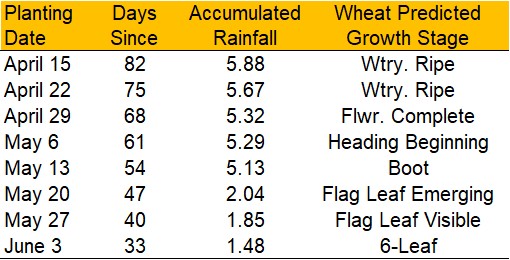
Predicted growth stage based on the NDAWN Growing Degree Day (GDD) model for Williston. Rainfall is based on Pioneer NDAWN station.
If you have been fortunate to receive consistent rains in comparison to others who have been missed recently, your scab risk is likely elevated compared to regional averages so keep that in mind when making your spray decision. In these fields also take note of foliar disease levels, which can reduce yield if it travels up the canopy and infects the flag leaf. This is most likely an issue where wheat has been planted on wheat residue.
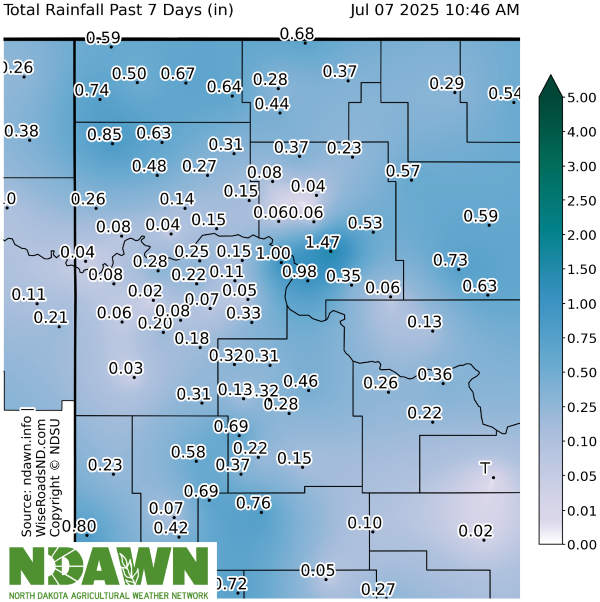
If you have any questions about head scab management please feel free to reach out.
Dr. Audrey Kalil
Agronomist/Outreach Coordinator
White Mold in Soybean and Dry Bean
As soybean and dry bean enter reproductive growth stages, they become susceptible to infection by Sclerotinia sclerotiorum the pathogen that causes white mold also know as Sclerotinia stem rot.Other crops that we grow which can host this pathogen include canola, peas, lentils and sunflower. Each infection cycle results in the production of black sclerotia which are the survival structures of the pathogen. They can remain viable for several years in the soil, so tight rotations of these host crops will increase risk of severe white mold.
The life cycle of the pathogen starts when the sclerotia germinate to form a mushroom-like structure called an apothecia (picture and diagram below).
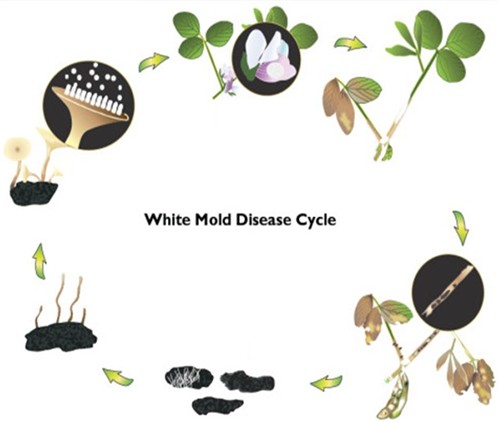
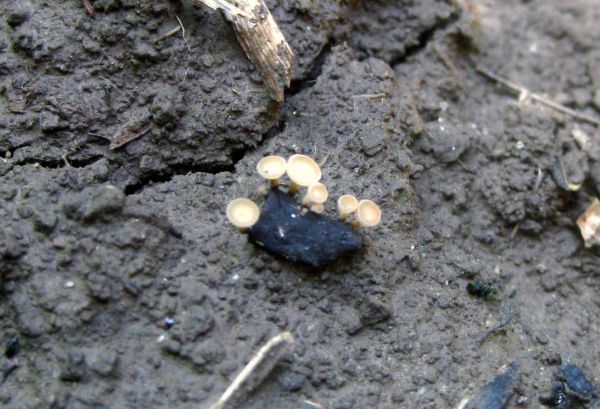
Sclerotia can germinate under a wide range of conditions but prefer moist soil conditions and temperatures in the 60s to mid 70s. According to NDAWN weather stations in Sidney and Buford, the average temperature over the last 30 days has been 65 and 63°F respectively. Despite recent warm temperatures, as long as soil moisture is adequate, air temperatures have been conducive to germination of sclerotia to form apothecia.
Each apothecium can produce millions of ascospores which land on host plants and infect under conducive environmental conditions, namely, high humidity, long periods of leaf wetness and moderate temperatures. While mid 70s are ideal, the disease can spread even when temperatures reach 90°F. Senescing flowers and leaves are the first tissue to be infected, so that is why we target fungicide applications to the reproductive stages. Prior to flowering, the pathogen is unable to infect the host plant.
Proper fungicide application timing is critical to maximize efficacy, especially since only a single application is usually made in our region. Research led by Dr. Michael Wunsch at the NDSU Carrington Research Extension Center shows that the optimal application timing differs between soybean and dry bean, and in soybean is relative to canopy closure. Canopy closure increases relative humidity and leaf wetness inside the canopy and aids in the development of white mold disease.
Soybean
If the canopy is open, apply a fungicide for white mold when 100% of plants reach the R2 growth stage. R2 is when there is an open flower at one of the two uppermost nodes.If the canopy is closed at R1, which is when plants have at least one open flower on any node, fungicides should be applied when 60-80% of plants have reached this stage.
If the canopy is closed at early R2, apply the fungicides at that stage.
Essentially, apply a fungicide at 100% R2 or when canopy closure coincides with flowering, whichever comes first.
Dry Bean
Disease reduction and yield benefits of a fungicide application are maximized when you apply a fungicide when 60-80% of plants have initial pin pods (R2). This is regardless of canopy closure. The charts below are from Dr. Wunsch’s fungicide studies where he applied 30-40 oz./ac of Topsin when the canopy closed when either 70-85% (top graph) or 10-20% (bottom) of plants had initial pin pods.

Fungicides protect the tissue they contact and do not protect new growth. Given that dry bean undergoes significant growth during early bloom, a later application time point makes sense. However, this timing sacrifices some early protection. We make this gamble knowing that normally our very hot and dry summers suppress white mold disease. If you are going to make two applications, you can shift that first application to a few days earlier to protect against early
infection as well.
Application Technique and Droplet Size
Droplet size matters when controlling white mold in soybean. This disease starts at the bottom of the canopy where the apothecia are producing spores. Fine droplets may provide excellent coverage of the top most leaves, but don’t have the necessary weight to penetrate a canopy. If the canopy is nearing closure when the fungicide is applied, Dr. Wunsch showed that applying a medium to coarse droplet can improve the response to fungicide. When the canopy was closed at the time of application the coarse droplet performed best. In these studies he was applying 5.5 to 8 oz/ac of Endura 70WG in 15 gal/ac of water. The chart below summarizes these findings. The optimaldroplet size for each canopy stage is highlighted in tan.

White Mold Risk Management
Fungicide decisions for white mold must be based on risk, not symptoms. Once the optimal application window is missed, it’s too late to manage the disease effectively. The latest NDSU Crop and Pest Report published July 3rd included an article from Dr. Wade Webster, Extension Soybean Pathologist, about a new model to determine white mold risk for soybeans in North Dakota. These risk models were developed based on trials conducted in the Great Lakes region and he has been working on adapting them to North Dakota. Most of his work to validate the models thus far has been in non-irrigated production in eastern ND, and he has not yet validated these models in western ND and in particular irrigated systems in western North Dakota. I would be very cautious of relying on these models until they have been validated in our region. Currently the model rates risk as high for dryland soybean in western ND while irrigated soybean is considered low risk, which doesn’t make a lot of sense.Hopefully in the future we can use these risk models to help us make white mold application decisions, but until then we have to rely upon knowledge of field history and local weather conditions. You also need to determine the level of risk you are willing to assume. If you plan to put that field into a rotation heavy on white mold susceptible crops it might be in your best interest to be proactive. Once pathogen populations are established they are very challenging to eradicate.
Dr. Audrey Kalil
Agronomist/Outreach Coordinator